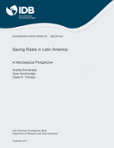Saving Rates in Latin America: A Neoclassical Perspective
Date
Sep 2017
Latin American countries have long exhibited low levels of saving rates when compared to other countries in relatively similar stages of economic development (e.g., Asian economies). Motivated by this fact, this paper examines the time path of the saving rates between 1970 and 2010 in three Latin American countries— Chile, Colombia, and Mexico—through the lens of the neoclassical growth model. The findings indicate that two factors, the TFP growth rate and fiscal policy (via tax rates and government expenditure), are capable of accounting for some of the major fluctuations in saving rates observed in these years. For instance, the impressive increase in Chile’s saving rate following the early 1980s debt crisis is likely to have resulted from a combination of high TFP growth and a tax reform that substantially reduced capital taxation. Counterfactual experiments also reveal that average saving rates in Latin America could have been some three percentage points higher, had the region experienced TFP growth similar to that of the Asian countries. This increase, however, is insufficient to bridge the observed gap between saving rates in the two regions.



